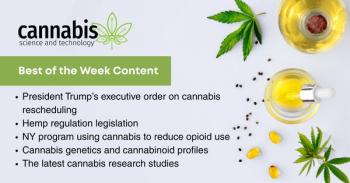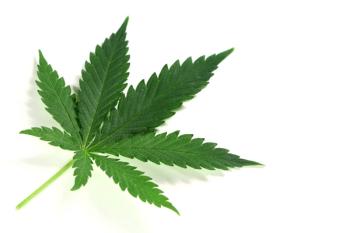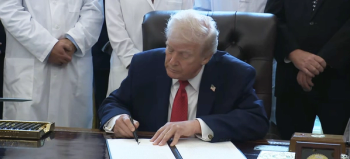
- August 2021
- Volume 2
- Issue 2
A Brief Overview of the History, Efficacy, and Safety of Cannabis for Epilepsy
An overview of the history regarding medical cannabis as a treatment option for epileptic disorders.
Epilepsy is a chronic disease characterized by overactive neuronal activity—abnormal electrical discharges—in the brain. Most new cases are diagnosed either in children or the elderly. The cause of primary epilepsy is unknown, while secondary epilepsy may result from a number of different conditions, including injury or stroke (1). With an incidence of about 50 cases per 100,000 people per year, epilepsy is one of the most common neurological diseases. Notably, roughly one-third of patients are drug resistant (refractory), meaning their seizures have not been controlled after using at least two different antiepileptic medications (2). Refractory patients suffer from intractable seizures, and treatment is often invasive (1). The severest forms of epilepsy are the developmental and epileptic encephalopathies (DEEs), each of which is relatively rare, but with a nontrivial overall incidence of one in 2000 births. DEEs are defined by frequent seizures, together with severe cognitive and behavioral impairment, morbidity, and mortality (3,4).
Cannabis for Epilepsy: Historical Use
Written records of cannabis use for epilepsy date back as far as 1800 BC. Cannabis was introduced to Western medicine during the 19th century by an Irish physician, William O′Shaughnessy, who had studied medicine in India, from where he brought back knowledge of therapeutic uses for cannabis to Europe. O′Shaughnessy’s own case reports note cannabis uses for “infantile convulsions.” By the late 19th century, cannabis appeared in Western pharmacopeias and was widely used to treat a variety of illnesses. During the early 20th century, however, Western medicine turned away from natural extracts to focus on chemical isolates, and eventually cannabis use was prohibited internationally (5).
Much anecdotal and pre-clinical evidence had been amassed that clearly suggested the efficacy of cannabis for epilepsy. Yet, the lack of scientists’ clear understanding of cannabis’s mechanisms of action for its pro-therapeutic effects for epilepsy deterred scientific interest in further research. It wasn’t until the early 1990s that the discovery of the endocannabinoid system revived interest in researching the therapeutic effects of cannabis for epilepsy, among other health conditions (5).
Cannabis for Epilepsy: Mechanism of Action
One role of the endocannabinoid system (ECS) is to dampen overactivity in the central nervous system (CNS), including preventing seizures. More specifically, endocannabinoids (eCBs)—cannabinoids produced by the body—act on endocannabinoid receptors (CBRs) located in central and peripheral neurons (CB1) and in receptors located in immune cells (CB2) (2).
The two most studied phytocannabinoids—cannabinoids produced by cannabis plants—are tetrahydrocannabinol (THC) and cannabidiol (CBD). THC causes greater psychoactivity and serves as an agonist primarily for CB1, but also for CB2. CBD, on the other hand, is nonintoxicating and has lower affinity for CBRs, where it serves as a weak antagonist (6). Both THC and CBD have been shown to be promiscuous, that is, they have affinities for dozens of different molecular targets (3,7).
Both THC and CBD have been shown to have anticonvulsant properties. There is also increasing evidence of ECS involvement in the process of epileptogenesis. However, the mechanisms of action (MOA) of THC and CBD for epilepsy have only been partially understood (6).
Studies show CBD blocks the uptake and hydrolysis of an eCB, anandamide (ANA), which increases ANA’s potential to activate the CBRs. Other potential MOAs include activation of transient receptor potential of: vanilloid type-1 receptors (TRPV1); G protein-coupled receptor 55 (GPR55); voltage-dependent anion channels 1, CaV3.x, 5-HT1A; glycine receptor; adenosine modulation; and sodium channels of GABAergic inhibitory interneurons (3,6).
Cannabis for Epilepsy: Survey of the Research
There is a substantial body of research on cannabis uses for treating epilepsy. A sizeable amount of preclinical research on cannabis for epilepsy has been performed. However, up until the last few years, most clinical research on cannabis for epilepsy has been low-powered, due to such problems as: small sample sizes, non-randomly selected participants, lack of control groups, lack of blinding, inconsistent interventions across participants, and poorly described cannabis products (2,8). At the same time, study participants were also generally taking a regimen of antiepileptic therapies, with variable consistency in dosing throughout the study period. Nevertheless, reported findings for nonrandomized studies, though slightly larger in magnitude, were still similar to findings from more recent randomized controlled trials (8).
Preclinical Research
Preclinical studies have shown that cannabis prevents seizures and reduces mortality in epilepsy. Studies have also shown that after chronic seizures have been experienced, the endocannabinoid system exhibits changes in homeostatic components that are both acute and chronic in nature (4). Finally, studies have shown that THC has produced both anticonvulsive and proconvulsive effects in animals (9–11), while CBD has exhibited clear antiepileptic effects (3).
Clinical Research
Case Studies
There are a multitude of case studies on the effects of cannabis for epilepsy. Some reports suggest pro-convulsive effects of cannabis. However, the majority of cases report either positive effects or lack of effect of cannabis for controlling seizures (4,11,12).
Surveys
There are also a multitude of surveys on the effects of cannabis for epilepsy. The estimated prevalence of cannabis use by epileptic patients ranges from about 4% to about 20%, with more evidence of incidence toward the higher end of the range. Again, the majority of surveys report either positive effects or lack of effect of cannabis for controlling seizures (4,11,13,14).
Non-Randomized Clinical Trials
As with both case study and survey research on the effects of cannabis for epilepsy, there is also a multitude of small-scale or non-randomized clinical trials on cannabis use for epilepsy. And as with both the case studies and surveys, the majority of the research reports either positive effects or lack of effect of cannabis for controlling seizures (1,2,4,6,8,15,16). More specifically, four classes of positive effects were reported for patients in treated groups relative to those in control groups:
- Reduction in seizures was achieved by a moderate to
substantial portion of patients - More than 50% reduction in seizures was achieved by a moderate portion of patients
- Freedom from seizures was achieved by a small but
nonzero portion of patients - Secondary improvements were achieved in the areas of quality of life, mood, alertness, behavior/aggression, sleep, language/cognition, and motor skills
Randomized Controlled Trials
There are a couple of larger-scale randomized controlled trials (RCTs) on the effects of CBD for epilepsy. These RCTs are all associated with clinical trials of Epidiolex on behalf of GW Pharmaceuticals for the purpose of gaining US Food and Drug Administration (FDA) approval of this drug. The RCTs indicated that GW’s CBD formulation may reduce seizures with high tolerability and low toxicity. As such, in June 2018, Epidiolex received FDA approval for the treatment of two specific DDEs, Lennox-Gastaut syndrome (LGS) and Dravet syndrome (17).
Points of Concern
Several points of concern, which warrant further discussion, can be gleaned from the research on cannabis for epilepsy.
Pro-Convulsant Potential of THC
Preclinical research and case studies indicate the potential for THC to have pro-convulsive effects (9,10,11,18,). Due to a combination of this pro-convulsive potential, together with its psychoactive nature, researchers have tended to shy away from clinical studies of the therapeutic potential of THC.
Further examination of this research reveals that THC may have pro-convulsive effects either when administered at “near-lethal doses” or when administered to subjects with a recessive genetic mutation (9,10,18). Other case study reports of cannabis causing seizure activity occurred in patients who had consumed either other drugs (for example, cocaine, LSD, amphetamines) or “street drugs” that could easily have contained other impurities responsible for the seizures (11).
On the subject of THC being pro-convulsant in humans, noted cannabis researcher Ethan Russo observes, “It should be mentioned that while there are claims of seizure exacerbation in humans by THC, these are isolated occurrences with no correlation to dosage, timing of administration, etc.” (18).
Pharmacokinetics
Both THC and CBD have been shown to inhibit cytochrome P-450 enzymes, that is, they interfere with the metabolization of other medications (1–4,6,8,11,14,16). In particular, CBD decreases the rate of metabolism of the common anti-seizure medication, clobazam. However, simply decreasing doses of clobazam seems to alleviate the effects (8,15).
Adverse Effects
Clinical studies indicate that the use of cannabidiol for epilepsy generally involves adverse effects. The majority of study participants experience adverse effects, including somnolence, diarrhea, decreased appetite, fatigue, lethargy, pyrexia, vomiting, and elevated liver enzymes (3,6,15).
Adverse effects reportedly dissipated upon cessation of dosing. Moreover, several studies noted that adverse effects were alleviated either by lowering doses of cannabis (or clobazam) (6,15) or by administering cannabis in forms alternative to the standard oil tinctures, such as through transdermal or vaporization administration (3).
Placebo Effect
Several researchers noted that cannabis has been receiving a lot of media attention lately, where CBD has been touted for its dramatic benefits in treating children with epilepsy. These media reports have created high expectations for many parents about the potential of CBD. Since the placebo effect is intimately tied to patient expectations, researchers have suggested that expectations created by media attention may be responsible for significant positive responses of study participants who were given placebos, rather than cannabis medicine (1,3,4,8).
In particular, a study performed in Colorado included subjects whose families had moved to Colorado to be able to access cannabis treatments, as well as subjects who had been native residents of Colorado. Results showed that study participants who had moved to the state reported positive responses to the medication (>50% seizure reduction) three times more often than study participants who had been long-time residents of the state. These differences in reported results could not be explained by differences in types of epilepsy, types of cannabis treatment administered, or other factors examined. Other similar examples were provided. Paradoxically, such a strong placebo effect makes it difficult for researchers to establish a true benefit attributable to medical cannabis (4).
Nevertheless, cannabis studies have observed statistically significant decreases in seizure frequency for epileptic children, a clinically important finding (8).
Forms of Cannabis Use
Two big challenges associated with studies of medical cannabis efficacy involve the forms of cannabis used in studies.
The first challenge is that cannabis formulations vary from study to study, which makes head-to-head comparisons across studies difficult. Preclinical studies tend to involve pharmaceutical grade or synthetic forms of CBD, THC, or other substances that act on the endocannabinoid-system (1,4). Next, surveys and retrospective studies tend to involve respondents who have used “cannabis,” without providing specific information about cannabis formulations (for example, CBD only, THC only, CBD and THC combined, minor cannabinoids and terpenes), form of use (such as smoking, vaping, tinctures, capsules) or dosing (for example, 5 mg/day, 50 mg/day) (1,6). Finally, clinical trials tend to differ in the types of cannabinoids used: synthetics, pharmaceutical grade isolates, or plant extracts (1,6). Again, the variation in cannabinoid type makes it difficult to compare outcomes across studies.
The second big challenge with studies of medical cannabis efficacy is their use of isolates—purified CBD or THC—which may be less effective in generating therapeutic effects than whole plant extracts. More specifically, cannabis researchers have emphasized the benefits of using plant extracts containing multiple compounds from the plant. Relative to using CBD or THC isolates, plant extracts enable patients to use lower doses that achieve better positive effects, with fewer negative effects (19). Studies that use cannabis isolates rather than extracts, as do most of the clinical trials, run the risk of biasing study results towards findings of lower efficacy.
Patient Versus Provider Safety Concerns
When considering the benefits and risks of different therapies, physicians tend to have very different perspectives than patients do. In particular, physicians tend to be risk-averse and eschew potential therapies that offer potential benefits, but that come with the risk of making patients worse off than they currently are. Patients, on the other hand, tend to be less risk-averse than providers: Patients live with the day-to-day reductions in quality of life caused by their ill health, and many patients are quite willing to risk further harm with a new therapeutic, if it comes with enough of a chance at improvement in their current state.
Roughly 30% of epileptic patients are treatment-resistant. As reported earlier, these patients suffer frequent seizures, together with severe cognitive and behavioral impairment, morbidity, and mortality. As seen by the relocation of many families with epileptic children to cannabis-friendly states, many of these treatment-resistant patients would willingly risk potential harms associated with using cannabis for the chance of reduction in seizures associated with cannabis use. Physicians should be aware of this difference in perspective.
At the same time, a non-trivial portion of epileptic patients who have participated in cannabis research indicate that they use cannabis as a means of addressing their epilepsy. Physicians who refuse to consider cannabis as a viable treatment for epilepsy thus risk not only alienating patients, but contributing to mistreatment, if patients simply decline to inform their physicians of their cannabis use.
References
- S. Reddy and V. Golub, The Journal of Pharmacology and Experimental Therapeutics PMID: 26787773 DOI: 10.1124/jpet.115.230151 (2016).
- S. Zaheer, Cureus PMID: 30443449 DOI: 10.7759/cureus.3278 (2018).
- S. Ali, et al. Developmental Medicine & Child Neurology PMID: 30402932 DOI: 10.1111/dmcn.14087 (2018).
- E. Rosenberg, et al. Neurotherapeutics PMID: 26282273 DOI: 10.1007/s13311-015-0375-5 (2015).
- D. Friedman and J. Sirven, Epilepsy & Behavior PMID: 28089286 DOI: 10.1016/j.yebeh.2016.11.033 (2016).
- T. Gaston and J. Szaflarski, Current Neurology and Neuroscience Reports PMID: 30194563 DOI: 10.1007/s11910-018-0882-y (2018).
- Prof of Pot, "THC & CBD – Promiscuous Partners With Many Receptors." Prof of Pot. (2017).
- J. Elliott, et al. Epilepsia PMID: 30515765 DOI: 10.1111/epi.14608 (2018).
- D. Feeney, Adv Biosci. PMID: 756849 DOI: 10.1016/b978-0-08-023759-6.50053-6 (1978).
- P. Martin and P. Consroe, Science PMID: 982057 DOI: 10.1126/science.982057 (1976).
- B. Whalley, American Herbal Pharmacopoeia. Retrieved from
www.semanticscholar.org/paper/CANNABIS-IN-THE-MANAGEMENT-AND-TREATMENT-OF-AND-%3A-A-Whalley/866ffa4a788d2548a321874050cbcfec84a372fd (2014). - D. Sulak, et al Epilepsy & Behavior PMID: 28254350 DOI: 10.1016/j.yebeh.2016.12.032 (2016).
- M. Sexton, et al Cannabis and Cannabinoid Research PMID: 28861489 DOI: 10.1089/can.2016.0007 (2016).
- A. Suraev, et al, Epilepsy & Behavior PMID: 28238865 DOI: 10.1016/j.yebeh.2017.02.005 (2017).
- O. Devinsky, et al., N. Engl. J. Med. PMID: 28538134 DOI: 10.1056/NEJMoa1611618 (2017).
- F. Pamplona, et al., Frontiers in Neurology PMID: 30258398 DOI: 10.3389/fneur.2018.00759 (2018).
- GW History & Approach. (n.d.) GW Pharmaceuticals (now Jazz Pharma). Retrieved from
https://www.jazzpharma.com/medicines/our-medicines/ . - E. Russo, Epilepsy & Behavior PMID: 27989385 DOI: 10.1016/j.yebeh.2016.09.040 (2016).
- R. Fisher, "Understanding Cannabis’s Entourage Effect." Retrieved from
https://medicalcannabisprimer.com/all-blogs/52-understanding-cannabis-s-entourage-effect (2020).
About the Author
Ruth Fisher, PhD, is a systems design researcher and analyst. She analyzes markets to determine how environments shape outcomes. She is co-founder of CannDynamics, Inc., and author of The Medical Cannabis Primer and Winning the Hardware-Software Game: Using Game Theory to Optimize the Pace of New Technology Adoption. Dr. Fisher has worked in the technology and healthcare sectors on behalf of technology companies, early-stage researchers, physicians, and technology start-ups.
Articles in this issue
over 4 years ago
August 2021 Digital Editionover 4 years ago
Medical Cannabis and Caregiver Rights in Hawaiiover 4 years ago
Charlotte Figi: Patient, Advocate, Trailblazer, and Much Moreover 4 years ago
Cannabis Becomes One Nurse’s Tool to Treat Epilepsy DisordersNewsletter
Unlock the latest breakthroughs in cannabis science—subscribe now to get expert insights, research, and industry updates delivered to your inbox.




